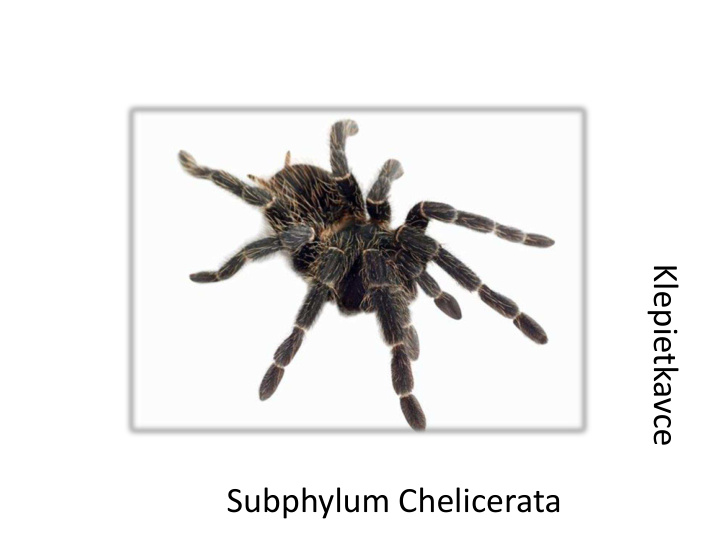



Klepietkavce Subphylum Chelicerata
Chelicerata (klepietkavce) - special mouthparts called chelicera
General characteristics - includes 2 classes - Xiphosura (horseshoe crab) - Arachnida (spiders, ticks, scorpions, & mites) - have a cephalothorax (fused head & thorax) and abdomen - no antenna - simple eyes or ocelli - have 6 pairs of jointed appendages: - chelicerae - claws or fangs (1 pair) - pedipalps - used for feeding, walking, sensing, transferring sperm (1 pair) - walking legs - movement (4 pairs)
Xiphosura - marine - not true crabs - fanglike pincers or chelicera - use book gills to breathe horseshoe crab – ostrochvost americký
Arachnids - terrestrial - 8 legs - chelicera or fangs with venom - ocelli - no antenna - breathe by book lungs or tracheal tubes
Spiders - feeds on insects ( carnivores ) - have oval shaped, unsegmented abdomen - cephalothorax connected by narrow waist to abdomen - have 8 simple eyes or ocelli - fangs pierce prey, inject poison & suck out body fluids - pedipalps on head help sense prey & move it to the mouth - hemocycanin is oxygen-carrying pigment in blood - have silk glands to make silk & spinnerets to release silk for webs - breathe by book lungs & tracheal tubes
Mites and ticks - parasitic arachnid - fused cephalothorax & abdomen - most abundant arachnid - need blood meal to molt - mites can damage fruit & feed on dead skin at base of hair follicle - ticks carry Lyme disease & Rocky Mountain Spotted Fever
Scorpions - have a cephalothorax & long segmented abdomen curled over body - prefer dry regions - poisonous stinger on end of abdomen - breathe through book lungs - pedipalps modified into claws - nocturnal predators
More recommend